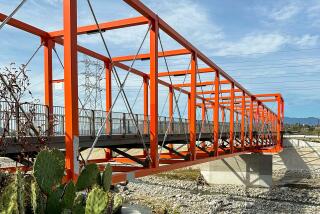Learning From the Silberman Bridge: Only Name Edifices After the Dead
- Share via
What’s in a name? Or: a bridge too far.
A question arises about retaining Richard T. Silberman’s name on a bridge over Interstate 15 at Clairemont Mesa Boulevard.
On the one hand, Silberman was key to getting I-15 built: no easy trick under Jerry Brown.
On the other hand, he has pleaded guilty to laundering drug money and is headed for federal prison. What happens when the kiddies from Tierrasanta ask mom about the man whose name is on the sign?
Municipal Court Judge Larry Stirling thinks we should leave well enough alone. When he was in the state Assembly, he introduced the resolution to name the bridge for Silberman.
“I do not believe in drugs, drug trafficking or money-laundering,” Stirling said, “but the bridge is a small thank-you for the massive contribution Mr. Silberman made prior to his current problems.”
Still, Stirling now sees wisdom in naming state edifices--buildings, libraries, freeways--only after dead people.
Dead these four centuries, Juan Cabrillo will never embarrass the public for having his name on a stretch of California 163 through Balboa Park.
Maybe there’s historic/Grey Line tour value in leaving the Silberman bridge sign intact. Much like other manifestations of San Diego political crookery: Uvaldo Martinez’s restaurants, Roger Hedgecock’s house (Perjury Count 12), and C. Arnholt Smith’s hotel across from City Hall.
Alas, not everybody sees it this way. There are always moral high-roaders.
Assemblywoman Carol Bentley (R-El Cajon), whose district includes the Silberman bridge, says she’ll introduce a resolution to make sure no public structure is named for a felon. If the conviction occurs after the naming, the name would automatically be dropped.
“I don’t think we want to honor someone who turns out to be a convicted felon,” she said.
Right now, there are no Silberman bridge signs.
They’ve been swiped by vandals/trophy hunters. Caltrans is supposed to replace them, but these things take time.
Putting His Best Face Forward
All over the place.
* Of me, I sing.
The four-page fall 1990 newsletter sent to constituents by Rep. Bill Lowery (R-San Diego) contains eight pictures of Lowery.
* As a teaching prop, San Diego State journalism professor Don Sneed videotaped a long talk with Charlton Heston on the art of interviewing.
Sneed figured the much-interviewed Heston would have lots to say about what makes a good questioner. He also thought Heston’s celebrity would make students sit up and listen.
But now Sneed has hit a snag: Half of his students aren’t sure who Heston is.
Ex-Mayor Makes Pledge, Not Bargain
Part of Roger Hedgecock’s current patter is that he’ll never, never be a candidate for political office again.
He repeated that promise during a combative interview for “San Diego Headliners,” taped this week and set to be shown at 10 a.m. Sunday on KNSD-TV (Channel 39):
“I will not be a candidate for mayor at any time in the future or for any other political office. I’ve found a new life.”
His inquisitors--Tim Chelling and Gene Cubbison, both of KNSD, and me--then asked if he would put that in writing.
To avoid further court agony, would you sign a no-run pledge for five years if the district attorney would ask a judge to drop the one-year jail sentence?
“I’m not going to bargain on the air,” Hedgecock shot back, “because those things have never been offered to me, and I’ve never offered them back.”
Translation: that sliver of light you see is from a door being left ajar for a possible comeback.
More to Read
Sign up for Essential California
The most important California stories and recommendations in your inbox every morning.
You may occasionally receive promotional content from the Los Angeles Times.













